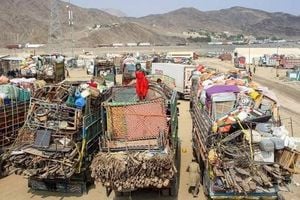A coalition of conservation groups and Native American tribal citizens is urging President Joe Biden to establish the proposed Maah Daah Hey National Monument, which would cover about 140,000 acres of untouched Badlands terrain in North Dakota. Tribal nations advocating for the designation express hopes this would protect not only the land's scenic beauty but also its rich indigenous history and cultural significance.
The proposed monument is planned to be located within the Little Missouri National Grassland and adjacent to the Theodore Roosevelt National Park—an area already steeped in American history, having been frequented by the 26th president during his youthful ranching days. The designation would encompass eleven noncontiguous sections, weaving through picturesque landscapes familiar to local recreation enthusiasts.
Michael Barthelemy, representing the Mandan, Hidatsa, and Arikara Nation, highlighted the deep link between the land and its people. "When you tell the story of the land, you must tell the story of the people who have inhabited it. How the land has shaped them and how they, in turn, shaped the land is pivotal to this narrative," he noted.
Action from the federal government is being requested at a time when there are fewer than two months left of Biden's current term, complicated by the impending transition to President-elect Donald Trump's administration. Supporters of the proposal have made trips to Washington, D.C., seeking engagement with multiple governmental officials, including those from the Interior Department and the U.S. Forest Service, which would manage the monument should it be established.
Scott Skokos, the Executive Director of the Dakota Resource Council, voiced the optimism within the coalition, stating their belief is unwavering, and they’re open to collaborating with the next administration. "This is about what's right for the land and its people, irrespective of political leadership,” he asserted.
This expansive area, rich with biodiversity and scenic vistas, faces threats from existing oil and gas developments. Despite this, the proposed monument’s supporters insist it contains no active oil or gas leases, hinting at its pristine condition and potential for preservation against future developments.
The effort to secure the monument's status is supported by various tribes, including the MHA Nation, the Spirit Lake Tribe, and the Standing Rock Sioux Tribe. Tribal official Lisa Finley-DeVille stressed both the environmental and cultural importance of the land, mentioning how the monument would facilitate reconnection for indigenous citizens with their ancestral roots.
North Dakota's Governor Doug Burgum, who has been selected by Trump to lead the Interior Department, has articulated dual beliefs: the importance of protecting North Dakota's natural resources and cultural heritage, alongside responsible energy development. This stance complicates the chances for the proposed monument, as many ranchers and state officials fear increased restrictions on land use and energy development.
While opposition exists—including skepticism from Senator John Hoeven's office over the level of local backing for the proposal—advocates stand firm on their commitment to fostering recognition of indigenous history within North Dakota.
Moving forward, the coalition emphasizes the monument's potential to educate visitors on the rich narratives intertwined with the Badlands, encompassing ancient ecosystems, unique geological formations, and fossil sites significant both ecologically and culturally.
Establishing the Maah Daah Hey as a national monument would not only be historic as North Dakota's first such designation but would also exemplify the federal commitment to honoring Native American contributions and safeguarding their cultural heritage.
The push for the Maah Daah Hey National Monument is not just about land preservation but is also about ensuring the legacy of indigenous peoples is woven permanently within North Dakota's narrative. This effort is as much about storytelling as it is about conservation, bridging the gap between the past and the future of the land.



